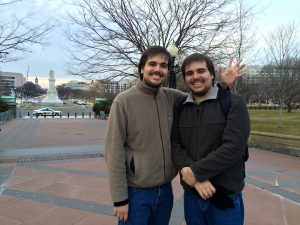In the fall of 2009, a series of new pilots from all the big broadcast networks were dropped onto iTunes for free, as they are at the beginning of every broadcast season. These networks do this to stir up buzz for their new shows, to make people actually watch all the following episodes.
I downloaded a bunch of them and started watching. Most of them were pretty good; Modern Family in particular seemed incredibly promising. But there was one pilot that had me hooked from the moment the episode began and captivated my attention with its sheer comic brilliance. And that was how I discovered Community.
Fast forward another five years and my entire high school career as Community sets to close it’s fifth season next week. The show has endured the threat of cancellation, the firing of it’s showrunner, the departure of cast members, and yet still remains one of the most consistently exceptional shows on television, constantly challenging the pedantic sitcom format by being “meta,” or self-referential.
At the moment, however, the future of the show is in question, as NBC decides whether or not to renew it for its sixth season. It seems as good of a time as any to take a look at the show’s history, to gauge its development to make “The Case For Community,” which will culminate next week with my thoughts on the third, fourth and fifth seasons as a whole.
Here we go.
Season 1 (Fall 2009-Spring 2010)
The real goal of every show’s first season is to make us care. We, as viewers, are thrust into a new world filled with new people that we can choose to either care about or ignore. If we care, we watch the show. We follow the characters’ struggles. We laugh. We cry. If we don’t, we do nothing.
Community truly took this idea to heart and used its pilot to introduce us to a seemingly divergent gang of misfits who join a Spanish study group at Greendale Community College that the “protagonist” Jeff Winger, a former lawyer who was disbarred for faking his college education, invented with the sole purpose of trying to sleep with Britta, who doesn’t seem all that interested. The other members are invited by Abed, who Britta brought on to provide a barrier between her and the persistent Jeff.
This group of seven, who gradually become referred to as “The Study Group,” spend this first episode in heated argument, exposing each of their back stories and personal flaws, before the issues are resolved and apologies are made. By the end of the pilot, we are very familiar with all of the characters, and feel at home in their study room.
This is potentially dangerous, however, as there is the threat for some shows to falter here by failing to develop their characters any further. Each character here could easily fit into a very general stereotype of the community college student, a fact that the pilot acknowledges in it’s opening act.
Luckily for Community, this is not the case. The rest of the season sees them arranged in all sorts of groups, becoming friends, developing animosities, eating chicken fingers. Their individual quirks, like Abed’s obsession with pop culture as a manifestation of his Asperger’s syndrome, Troy’s sensitive nature in spite of his athleticism, Pierce’s complete ignorance of modern sensibilities as misguided attempt to be cool are borne out of the stereotypical shells introduced in the pilot.
Yes, at the end of the day, the genius of season one is in this development, which feels effortless due to the talent of the cast and nuance of the scripts. No episode appears to be something we have seen before, as each places a different character in the spotlight and forces them to deal with a fresh problem. The cast members are given the opportunity to play off each other cast member in some capacity, which gives the season a very organic, natural vibe, despite some extremely unique, unprecedented storylines.
As the season closes, despite a twist in the last seconds of the finale, we are part of the study group. The characters are our friends. We go to Greendale. And we’re not going anywhere.
Notable Episodes (These episodes are all notable because some are extremely important plot-wise, some successfully break the standard format, and some are just absurdly funny. I’m going to have to keep myself to four notables on all of these. But honestly, there are so many more standouts. I guess you’re going to just have to look for them yourselves.) : “Pilot,” “Debate 101,” “Contemporary American Poultry,” and “Modern Warfare.”
Season 2 (Fall 2010-Spring 2011)
Community’s second season is often highlighted as the show’s best. In fact, in a post on Tumblr, Dan Harmon, the series’ showrunner and creative director, ranked the second season as his favorite of the first three. But why?
The end of the first season left us with an extremely cohesive group of seven, who had grown a great deal through the unconventional and often ridiculous exploits and tropes of life at Greendale. The brilliance of the second season lies in how it chose to further develop these characters: by being even more ridiculous than before.
This is only possible because the second season has no need for expository episodes to introduce us to the characters. It can simply throw them in absurd situations where their intricate relationships can play themselves out on a massive scale.
Take the Christmas special “Abed’s Uncontrollable Christmas.” The driving force behind this absolutely bizarre concept is Abed’s attempt to cope with his emotions and a letter from his mother. He does this by envisioning himself in a world entirely in stop motion, which is rendered in the actual episode that is shot in this format. Each character is depicted as “silicone dolls with foam bodies over ball and socket armatures,” to model the stop-motion Christmas specials of the 80s. In the episode, the gang is transported to “Planet Abed,” where they search for the true meaning of Christmas.
Conceptually, this idea sounds just plain silly. But somehow, it manages to be one of the most emotionally compelling and funny episodes of the season. This is because we, as viewers, have such a comprehensive understanding of the characters. We are able to suspend our disbelief and accept these crazy situations because the characters act exactly as we’d expect them to.
Season two, in general, just works. The ludicrousness of the situation just lends itself to comedy, which is delivered perfectly by the hilarious cast. And plus, it saw the use of a capuchin monkey for its structural narrative. What more could you ask for?
Notable Episodes (For real though. Season Two is ridiculously good. Go watch all of it.) : “Conspiracy Theories and Interior Design,” “Abed’s Uncontrollable Christmas,” “Advanced Dungeons and Dragons,” “Paradigms of Human Memory.”
Photos: IMDB






Community is the bastard child of hilarity. Jeff Winger is one of the funniest characters on TV. Donald Glover and Joel Mchale’s exchange on the football field in season one is possibly one of the funniest things I ever saw. His name began with a T.